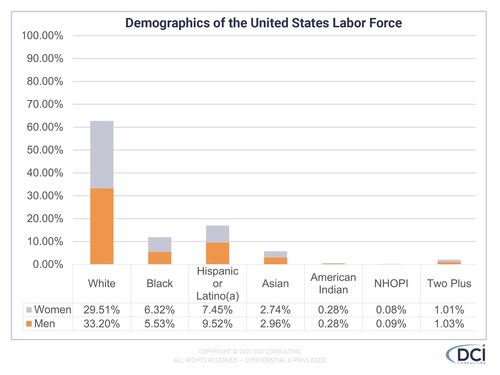This article is the first in a new series, “Diversity at a Glance,” from DCI Consulting (DCI) that will explore labor force benchmarks within and across sectors. With the increased awareness around social justice movements, more employers are examining the diversity profile of their workforces. However, employers are frequently concerned about the lack of robust and meaningful benchmarks against which to compare their workforces. With the recent release of the EEO Tabulation 2014-20181 by the United States Census Bureau, more timely labor force data is now available for companies to use in evaluating diversity.
HR Technology News: RiseBird, India’s Leading Video Interviewing Cloud Platform, Clocks 500 Daily Interviews
This series of articles will focus on various employment sectors. “Sectors” are essentially the broadest tier in the North American Industry Classification System’s (NAICS) hierarchical structure. Sector data captures subsector and industry group data within it. DCI will share demographic insights on various sectors to bring more diversity awareness to employers. There will be more to come on the advantages and vulnerabilities of this source data, as well as alternative source data, at the conclusion of this series. Although this series will not provide comparisons at refined levels such as EEO-1 Category or job level, it will allow for a high-level diversity review within particular employment sectors.
The chart below displays the representation of women and people of color in the total labor force. These employment percentages create a baseline to compare to various employment sectors.
This baseline chart shows that the employment rate of White women in the labor force is 29.51%, but women across all races is 47.39%. It also shows that the employment rate of Black women in the labor force is 6.32%, but percent of Black employees in the labor force is at 11.85%. Various other demographic groups are reported on this chart.
DCI’s series on labor force benchmarks will initially explore the sectors which represent employees doing vastly different work. The series will compare representation in these sectors to the participation rates depicted in the general chart.
HR Technology News: MindEdge and HRCI Study: 80% Of HR Professionals Report Increased Staff Burnout During the Pandemic
In this series, we will explore the data within sectors and ask questions, such as:
- How do specific sectors differ in representation compared to the overall labor force?
- What race and sex intersectionality differences exist between sectors?
- What are the strengths and weaknesses of this data source if using it for diversity measurements?
Our observations from this review will provide a perspective on opportunities that exist to develop efforts to address equity in the workforce. We will end the series with ideas for utilizing diversity data sources such as this EEO Tabulation 2018 in diversity benchmarking projects and in identifying barriers that may exist for the employment of women and people of color. This series should help employers in certain key sectors consider how they can, at minimum, mirror the diversity of their sector.
HR Technology News: New Data From Lattice Show That 70% Of HR Teams Are Planning for Blended Workforces Well Into 2022
[To share your insights with us, please write to sghosh@martechseries.com]


